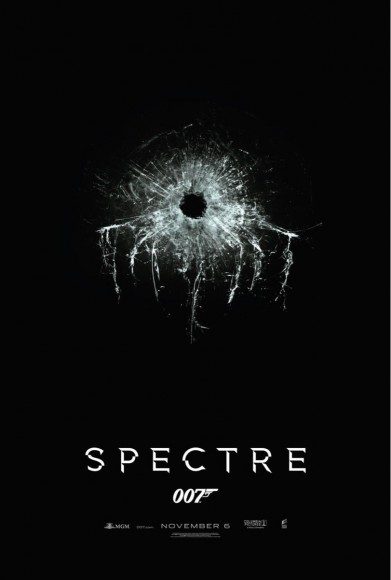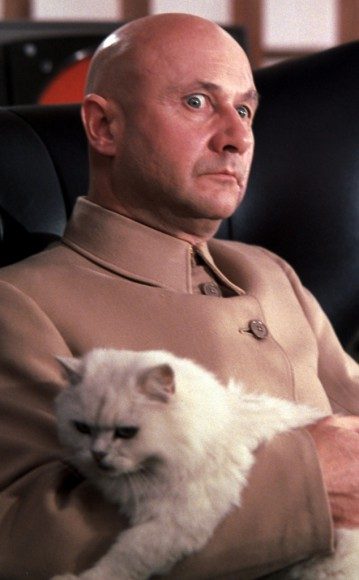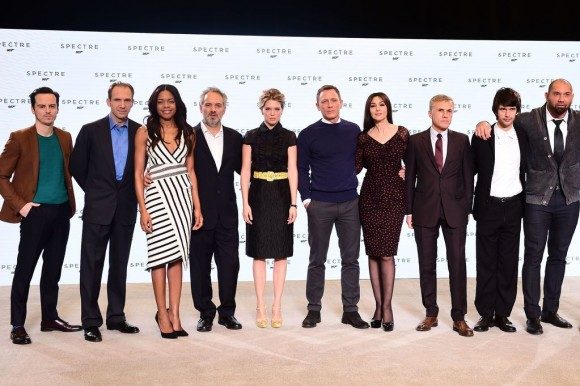

It’s an annoyingly common saying that you can best define heroes by their villains, which makes it all the more remarkable that one of pop culture’s greatest icons has been without his arch nemesis for over four decades. But that will change next year when the 007 family welcomes Ernst Stavro Blofeld back into its fold with Bond 24, aka SPECTRE, featuring the return of the so-named global terrorist group. And it is quite probably the best thing to happen to the franchise since Daniel Craig got his license to kill.
First introduced in Ian Fleming’s 1961 novel Thunderball, SPECTRE (the acronym for SPecial Executive for Counter-intelligence, Terrorism, Revenge and Extortion) rose to prominence as an essential part of James Bond movie canon, starting as the group responsible for the activities of his first cinematic adventure, 1962′s Dr. No. In contrast to the traditional USSR villain during the height of the Cold War, SPECTRE was a group of terrorists and criminals who were dedicated to pure evil more than any real political or cultural ideology. Relishing in its role as world puppet master, it liked pushing the superpowers to the point of war just to reap the spoils. With the exception of Goldfinger, it was pulling the strings throughout the entire Connery/Lazenby era (1962-1971), which was easily the best James Bond period up until (arguably) the modern era. (Interestingly enough both the third film in Classic Bond and the third film in Modern Bond will be the only ones not to place the group in the villain role.)
Unfortunately, due to a copyright dispute, SPECTRE disappeared from the film series (with the exception of a goofy reference in the cold open to 1981′s For Your Eyes Only) with the introduction of Roger Moore in 1973. Yet all these years later, it’s as much part of the mythos as the gun barrel and the Monty Norman theme.
SPECTRE helped give that first decade of James Bond the classy yet strange style that makes the films remarkably of their own time yet still fun to watch. Faces shrouded in darkness making decisions over life and death, knives hidden in shoes, and secret lairs with stolen art masterpieces were all elements that built the Bond legacy and made the universe a unique place to visit. Beyond the gadgets, the quiet, intellectual control featured by SPECTRE and its leaders helped set the films’ tone and pacing by making the actions from both sides seem more precise and methodical. The second film, From Russia with Love, showed SPECTRE at its most grounded and intimidating, and that movie, more than any other, could be seen as the progenitor to Modern Bond. Additionally, its leader Ernst Stavro Blofeld (played by numerous people throughout the years, including once a pair of hands with a cat) set the maniacal standard for every future James Bond villain, and gave pop culture one of its most famous parody characters in Dr. Evil (inspired by Donald Pleasance’s performance in You Only Live Twice).


Donald Pleasance as Ernst Stavro Blofeld in You Only Live Twice
But SPECTRE represented more to James Bond than volcano islands and scenery chewing villains. It represented a true threat for 007 and a real danger to the world. No matter what MI6 managed to accomplish, there was this nigh-unstoppable group with as much power and intelligence that was always ready to challenge them and escape virtually unscathed. It was an equal against which Bond and his team would constantly need to prove their mettle. It was also the only villain of the classic era to hit Bond personally, by killing his wife at the end of On Her Majesty’s Secret Service.
With the loss of SPECTRE, James Bond drifted throughout the Moore, Dalton, and Bronsan years without a true challenger. With eyes towards the sea (The Spy Who Loved Me), space (Moonraker), and Silicon Valley (A View to a Kill), villains ranged from the passable to the ludicrous, but they were standalone bad guys who were no more threatening than the villain-of-the-week in any procedural series. As goofy as parts of SPECTRE might have been (though they fit with the style of the time), they were an omnipresent threat, a component that has been sorely lacking in this franchise. Its organizational nature, and knowing that there were genuinely talented people who dedicated themselves to its goals, made SPECTRE far more ominous than one super rich megalomaniac with a bunch of expendable henchmen.


The SPECTRE Logo
The announcement last week that the next James Bond movie will bring SPECTRE back in SPECTRE (I’m not so thrilled about having the name as the sole title, though…) definitely gives 007 new lifeblood that it would have needed sooner rather than later. What makes this news especially exciting is how the style of Modern Bond can further bolster SPECTRE’s reemergence. One of the strongest components of this new era is the increased importance given to MI6 as a whole. In Classic Bond, characters such as M and Q really only existed to give Bond his mission and his gadgets, respectively. Bond generally had a good rapport with his support staff, but they weren’t really characters. In three movies, Daniel Craig and Judi Dench established a relationship far more interesting and complex than the previous 40 years of the series combined, and Skyfall indicated that they’re continuing down that path with Daniel Craig’s Bond and Ralph Fiennes’ Gareth Mallory (the new M). This “focus on the family” may end up applying to SPECTRE insofar as it sets the two organizations up against each other rather than one man against the entire group – though naturally Bond vs. Blofeld would be a key battle in that war.
The increased presence of MI6 in Modern Bond has also highlighted the global importance of Bond’s accomplishments in a way Classic Bond was rarely able to. Even Skyfall, which was more about one man’s quest for revenge against MI6, showed how the villain’s activities impacted and threatened the lives of average people in a far more personal and intimate way than previous era ever did. If applied to SPECTRE, this level of seriousness can make them into a threatening presence that will keep 007 and crew perpetually having to up their game and allow the audience to really understand the destruction they can sow. Gone (hopefully) are the days of the underwater lairs, but a Blofeld with the dignity of a Fiennes or Dench can make the James Bond franchise into an ongoing cat-and-mouse game that would serve it best.
The attempt at building a criminal syndicate has certainly been an element of Modern Bond since Casino Royale. Both that film and Quantum of Solace used the mysterious group Quantum as an overarching thread – with many viewers theorizing that entity was really just SPECTRE in hiding, thus showing the pull it continues to have on Bond aficionados. The makers of Casino Royale showed they understood the importance of having an organization that could provide 007 with a unified and continuous threat, and that went a long way in giving depth and gravitas to what was functionally a franchise reboot. But only SPECTRE is SPECTRE. You can put clown make-up on any psychopath, but there’s only one Joker, regardless of how many people play him.
Despite the changing times and style of the Bond films, people have been clamoring and hoping for SPECTRE to return for more than 40 years. It’s the missing piece to the 007 puzzle, and this return is as significant to the future of the franchise as it is to its past. Now let’s just have them admit that Christoph Waltz is Blofeld already.


